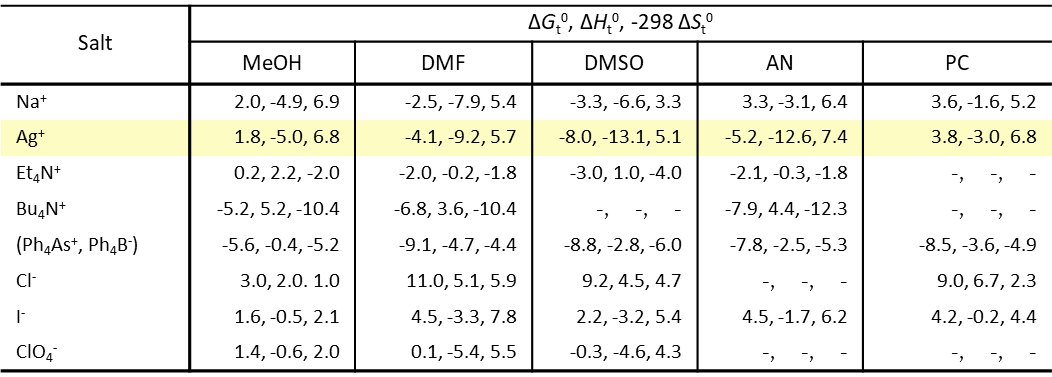Part 6: Factors involved in solvation of ions (2)
(c) The structure of water molecules that can form hydrogen bonds between them, so their entropy value is low.
The structure of water molecules can form hydrogen bonds between them, so its entropy value is low. When hydrophilic ions (many inorganic ions are hydrophilic) enter the water, the strong interaction between the water molecules and the ions causes the overall structure of the water around the ions to be disrupted, increasing their entropy.
However, when hydrophobic ions such as tetraalkylammonium ions (NR4+) and tetraphenylborate ions (Ph4B-) enter water, the water molecules around the ions, which are distant from the ions, further bind and increase their hydrogen-bonded structure (structure formation), which decreases their entropy.
As a result, these hydrophobic macro ions become unstable in water, while they can be more stable in organic solvents without hydrogen bonding structures (see Table 5).
 Based on the exothermic thermodynamic assumptions. The relationship of ΔGt0(Ph4As+) = ΔGt0(Ph4B+), ΔHt0(Ph4As+) = ΔHt0(Ph4B+), ΔSt0(Ph4As+) = ΔSt0(Ph4B+) are established. The unit is kcal mol-1.
Based on the exothermic thermodynamic assumptions. The relationship of ΔGt0(Ph4As+) = ΔGt0(Ph4B+), ΔHt0(Ph4As+) = ΔHt0(Ph4B+), ΔSt0(Ph4As+) = ΔSt0(Ph4B+) are established. The unit is kcal mol-1.
Tetrabutylammonium perchlorate and tetrahexylammonium perchlorate, which are almost insoluble in water, can be well dissolved in organic solvents and used as supporting electrolytes.
(d) When considering Lewis acid-base interactions, it is necessary to distinguish between the "hard" and "soft" properties of acids and bases.
In other words, it is easy for hard acids and hard bases, soft acids and soft bases to interact with each other. This effect can be significant even in the solvation of metal ions.
For example, Fig. 6-1 shows the coordination of the hard base N-methylpyrrolidone (NMP, whose oxygen atom is coordinated with the metal ion) and the soft base N-methylthiopyrrolidone (NMTP, whose S atom is coordinated with the metal ion). Since these half-wave potentials are based on the half-wave potential of the bisbiphenylchromium(I) complex (which is considered to show an almost constant value regardless of the solvent), the metal ions in the two solvents, the solvation effect is that hard acids such as Na+ and K+ have a strong solvation effect in hard alkaline NMP, while soft acids such as Cu+ and Ag+ have a higher degree of solvation in soft alkaline NMTP solvents. Similar phenomena were observed in dimethylformamide DMF and dimethylthioformamide DMTF.
(e) The DN value of acetonitrile (AN) is relatively small, so the solvation of metal ions in AN is generally weak.
However, monovalent metal ions such as Ag+ and Cu+ are different in acetonitrile (AN) solvents and have very strong solvation and stability. (Compare Ag+ Δt0 in acetonitrile and propylene carbon PCs in Table 5). This is due to the d electrons feeding back from the metal ions to the nitrile group. Therefore, silver and monovalent copper ions are not easily reduced to metals in acetonitrile solvents.

